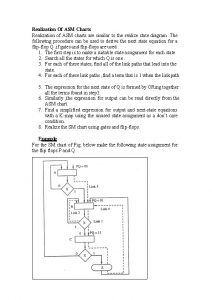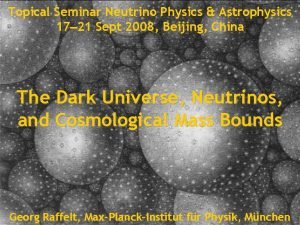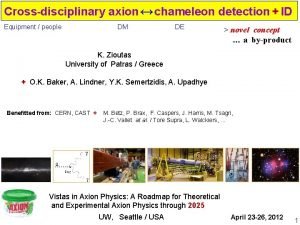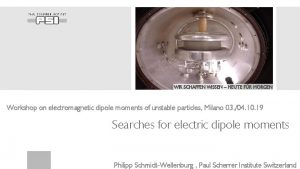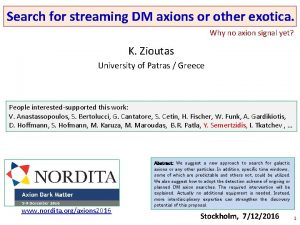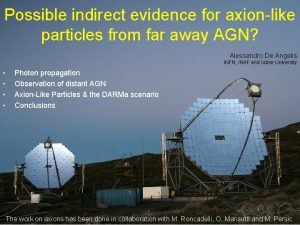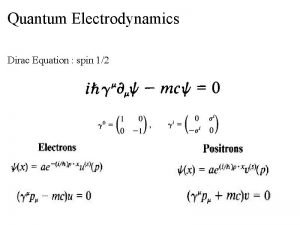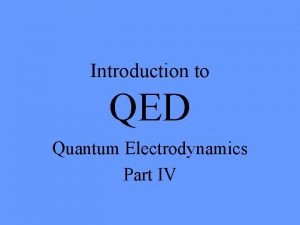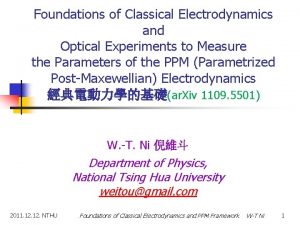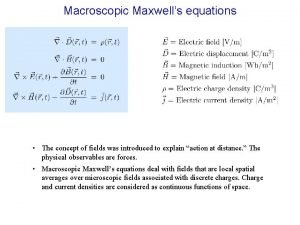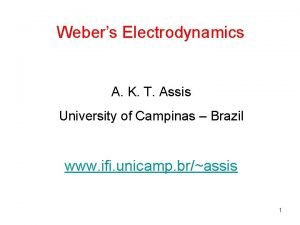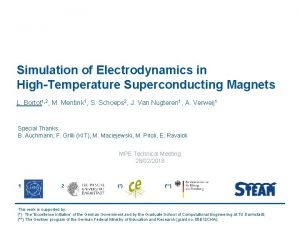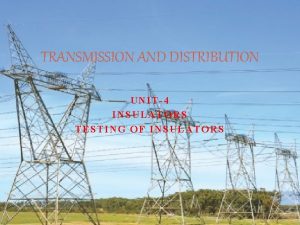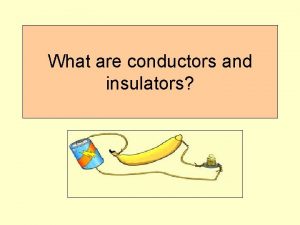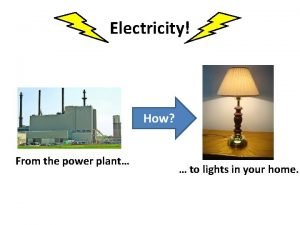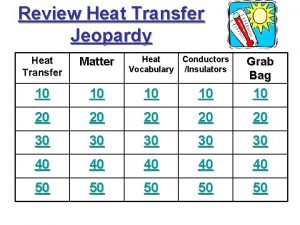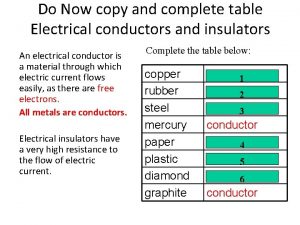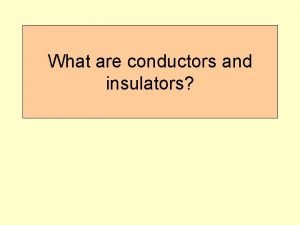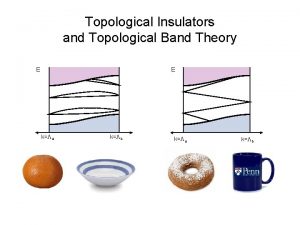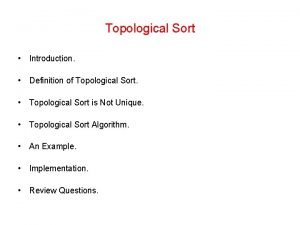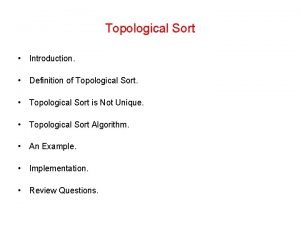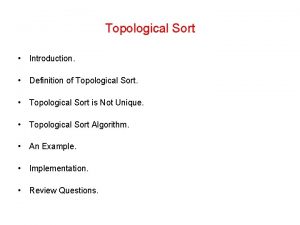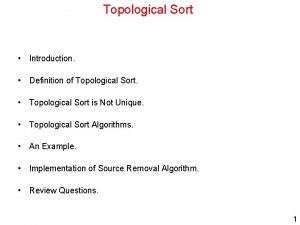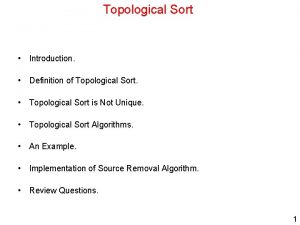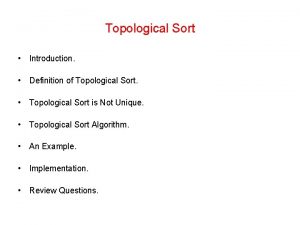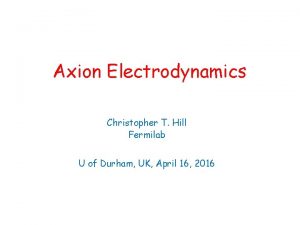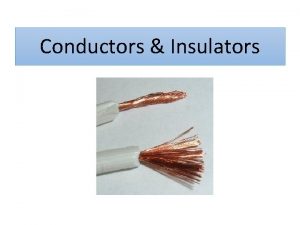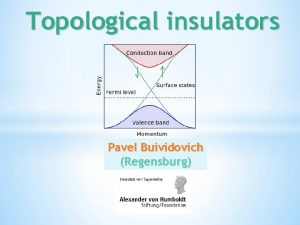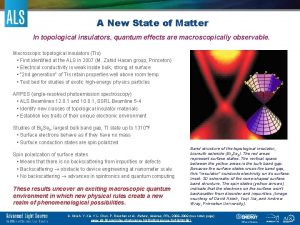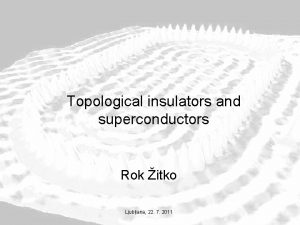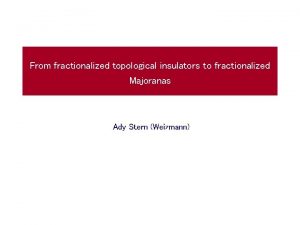Realization of Axion Electrodynamics on Topological Insulators June

























- Slides: 25

Realization of Axion Electrodynamics on Topological Insulators June 1, 2016 Jisoon Ihm Department of Physics POSTECH

Axion Electrodynamics on Topological Insulators

Collaborators Yea-Lee (Postech) Hee Chul Park (IBS) Young-Woo Son (KIAS) Y. -L. Lee et al, PNAS 112, 11514 (2015)

1. Motivations – Work function W F, W F’, W’ constant potential inside the metal e (f – f’) = -(W-W’) : potential gradient -W’ • In general, the work function (W) depends on surface orientations. • Thus, there should be a potential gradient across the facets.

1. Motivations – Surface dependent work function on TI W W’ Metallic states exist on all surfaces of TI; work function(vs. ionization potential) is well-defined. Surface dependent work function Insulating bulk e (f – f’) = -(W-W’) : potential gradient Nontrivial topology of Bi 2 Se 3 Topological magnetoelectric effect described by axion electrodynamics

2. Electronic structures of Bi 2 Se 3 – Crystal structures top surface (111) side surface (110)

2. Electronic structures of Bi 2 Se 3 – Band structures from ab-initio study top surface (111) side surface (110) Well defined single Dirac cone on each surface (distorted on [110])

2. Electronic structures of Bi 2 Se 3 – Work functions depending on surfaces top surface (111) side surface (110) • Work function of (111) = 5. 84 e. V, Work function of (110) = 5. 04 e. V • 0. 80 e. V difference in work functions between (111) and (110) facets

2. Electronic structures of Bi 2 Se 3 – Work function around nanorod Bi 2 Se 3 (insulator with surface states) Al (metal) C. J. Fall et al. , PRL 88, 156802 (2002)

Topology of 2 D Brillouin Zone : 2 -Torus

cf I. Characteristics of TI (compared with NI) s-state p-state s-state

cf II. Characteristics of TI (compared with NI) Background knowledge

cf II. Characteristics of TI (compared with NI) TI 0 TI NI T/2 0 0 0 G/2 Correspondence to energy bands Time-reversed pairs of Wannier states (switching partners or not) L. Fu and C. L. Kane PRB 74, 195312 (2006) and 76, 045302 (2007)

cf III. Characteristics of TI (compared with NI) L. Fu and C. L. Kane PRB 74, 195312 (2006) Because of restriction by TRS, wavefunctions cannot be defined continuously over the grey region. (which is called “obstruction” : two patches(A and B) are required to cover the grey region. ) Integral of the transformation matrix between two patches in the overlapping region becomes nonzero. This value actually agrees with the one in cf II (Product of Pfaffians, or number of zeros of Pfaffians).

cf IV. Characteristics of TI (compared with NI): Phenomenological description using field theory Unusual electronic structure of TI may be represented by Axion Lagrangian. ( , and q is axion field determined by topology. )

3. Topological magnetoelectric effect – Modified Maxwell equations by axion field Modified Maxwell equations constitutive relations F. Wilczek PRL 58, 1799 (1987) X. -L. Qi et al. , PRB 78, 195424 (2008): S. -C. Zhang group Topological magnetoelectric effect can be described phenomenologically in terms of axion electrodynamics.

3. Topological magnetoelectric effect – TME in TI with broken TRS-breaking gap for surfaces states by FM; one sign of current ( ) is chosen. Fermi level should lie inside the gap. Apply external electric fields E (In our case, E already exists in TI. ) Circulating Hall current flows X. -L. Qi et al. , PRB 78, 195424 (2008) (Magnetization: ) : dissipationless (bound current)

4. Axion electrodynamics in TI – The model Assume that 1) T-breaking gap for all surfaces 2) Fermi level is inside the gap

4. Axion electrodynamics in TI – A new numerical approach Variational problem of ‘axion electrodynamics’ Minimization of F with Dirichlet boundary conditions. (boundary conditions) Numerically solve it using finite element method

4. Axion electrodynamics in TI – Potentials Electric potential (V) Magnetic scalar potential (10 -6 C/s)

4. Axion electrodynamics in TI – Fields Electric field (107 V/m) Magnetic field (Gauss) At 5 nm above the corner, E ~ 4 x 107 V/m and B ~ 140 m. Gauss

4. Axion electrodynamics in TI – Smoothing boundary conditions Electric field (107 V/m) Magnetic field (Gauss) At 5 nm above the corner, E ~ 2. 6 x 107 V/m and B ~ 130 m. Gauss

4. Axion electrodynamics in TI – Near the edges Electric potential (V) Electric field (107 V/m) Magnetic scalar potential (10 -6 C/s) Magnetic field (Gauss)

4. Axion electrodynamics in TI – Comparison with the previous result potential gradient F, W F’, W’ TI X. -L. Qi et al. , Science 323, 1184 (2009) Work function difference of 0. 8 e. V B ~ 140 m. Gauss at 5 nm above the corner Electron gas of n=1011/cm 2, R=1 mm B ~ 1. 7 m. Gauss

Conclusions 1. There is a large work function difference between surfaces of different orientations of TI. 2. Large electric fields inside the TI give rise to the magnetic ordering along the edges through the topological magnetoelectric effect. 3. Our demonstration can be a useful basis to realize the axion electrodynamics in real solids.
 Asm chart for jk flip flop
Asm chart for jk flip flop Axion
Axion ;,dk jhd'v
;,dk jhd'v Chameleon ea performance
Chameleon ea performance Axion particle
Axion particle Axion
Axion Axion particle
Axion particle Quantum electrodynamics equations
Quantum electrodynamics equations Yukawa potential derivation
Yukawa potential derivation Quantum electrodynamics applications
Quantum electrodynamics applications Electrodynamics
Electrodynamics Maxwell's equations
Maxwell's equations Electrodynamics
Electrodynamics Electrodynamics
Electrodynamics Magnetsl
Magnetsl Testing of insulators
Testing of insulators Youtube.com
Youtube.com How does a rubber rod become negatively
How does a rubber rod become negatively What are conductors?
What are conductors? Insulators and conductors
Insulators and conductors Five types of energy
Five types of energy Jeopardy
Jeopardy Table of conductors and insulators
Table of conductors and insulators What are conductors
What are conductors Studyjams
Studyjams Voltage in parallel circuit
Voltage in parallel circuit
